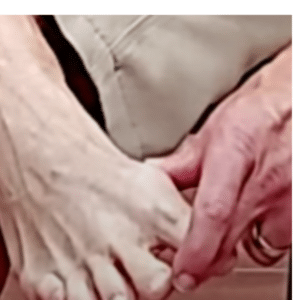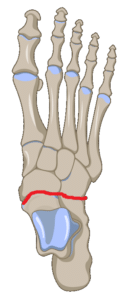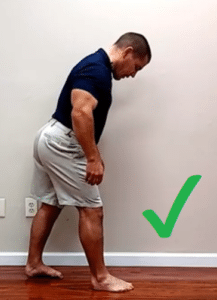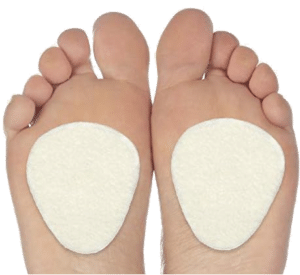Do You Get Pain In The Ball Of Your Foot When Walking?
Watch this video to learn what causes ball of foot pain walking, and what footwear, exercises, and other treatment you can do to walk more comfortably without pain in the ball of your foot.

What Causes Ball Of Foot Pain Walking?
The medical term for it is metatarsalgia, which basically means pain in the metatarsal bone in your foot. The ball of your foot is actually the "head" of the metatarsal right where it joins with the toe at the metatarsalphalangeal joint (MTP joint).
However, there are various different things that can cause pain in the ball of your foot.
Metatarsalgia is not just one thing.
You can have pain in the ball of the big toe, which is probably the most common.
However, you can also have pain in the balls of the little toes.
In this post, we'll cover:
- Shoe causes of ball of foot pain when walking
- Hands-on treatments that you can to relieve pain in the ball of the foot
- Exercises to help ball of foot pain when walking
- Shoe inserts and other products to help ball of foot pain.
Shoe Causes Of Ball Of Foot Pain When Walking
Shoes are a major cause of pain in the ball of your foot.
Largely, shoes that are too narrow or that have a pointed toe box jam your toes into a narrow space.
Your foot is normally shaped like a fan such that the toes splay out.
But when you're in shoes, most shoes have a toe box that goes into a point.
This can cause you to develop a bunion (hallux valgus) in your foot.
So, shoes don't necessarily allow your foot function the way that it should function in nature.
Additionally, shoes that are too narrow can compress your toes together causing pressure on the nerves in your foot. This can cause a condition knowns as Morton's neuroma.
So, if you do have pain in the ball of your foot, you want to make sure, one, that you have shoes that are properly fit both in width as well as in length.
Shoes that are too short can cause a deformity known as hammer toes.
This can also result from wearing high heels.
With hammer toes, your toes are extended at the ball of foot joints and flexed at the toe joints.
This makes the balls of the foot very prominent position which can create ball of foot pain when walking.
Shoes for ball of foot pain
If you have pain in the ball of your foot, you also probably want to wear wider, flat-heeled shoes.
Altra brand shoes are a good choice. Altra shoes have a wide, FootShaped™ toe box.
Additionally, many styles like the Altra Provision 7 have a zero-drop heel so that you're not putting extra pressure on your toes.
ALTRA Provision 7 Orange/Black 13 D (M)
(as of July 26, 2024 00:21 GMT -05:00 - More infoProduct prices and availability are accurate as of the date/time indicated and are subject to change. Any price and availability information displayed on [relevant Amazon Site(s), as applicable] at the time of purchase will apply to the purchase of this product.)Orthotics for ball of foot pain walking
Additionally, it can be helpful to use orthotics or arch supports that help maintain the natural arches of your foot.
You actually have three arches in your foot:
- Medial longitudinal arch on the inside of the foot
- Lateral longitudinal arch on the outside of the foot
- Transverse arch, which runs across the foot.
We'll go over the biomechanics that affect those various arches later in this post.
But for now, shoes that are wider, low-heeled, and that have good arch support are a good place to start.
Hands-on Treatment For Ball Of Foot Pain
These ball of foot pain self-treatments will focus on a few different joints.
Treatments for ball of foot pain in big toe
You should have about 70 degrees of extension from the metatarsal to the big toe.
So, you need to be able to get your big toe to bend backwards toward the top of your foot.
Sometimes that means you actually have to take the metatarsal and pull it down as shown to allow the big toe to extend.
Additionally, if you have a bunion, you want to pull the toe outwards so that it's lined up with the metatarsal and not pointing inwards.
Depending on how much bone you have built up, you may never get it back to a perfectly normal alignment. However, you want to try to pull it out as best as possible so that it can act as a post to keep you from overpronating when you're walking.
Treatments for the midfoot
Additionally, you want to check underneath the midfoot.
You've got a joint here called your mid-tarsal joint, which joins your rearfoot and your forefoot.
If you overpronate, that mid-tarsal joint can get too flexible, bones can start to drop down into the arch of your foot.
To assess for that, you want to run your fingers along the bottom of your foot and see if there's anything that sticks out. The bones may be sore and tender to touch.
Then just place your thumb on the tone that's dropped down and pull the first metatarsal down around it as shown below.
Treatments for the transverse arch of the foot
Next is for the transverse arch of your foot, the arch that goes side-to-side across your foot.
For various reasons, particularly if you overpronate, that makes that mid-tarsal joint too flexible.
You can lose the transverse arch that goes over the top of the foot and it can cause your foot to flatten and spread out. This makes your foot effectively wider.
To reform the transverse arch take your fingers and kind of put them down the middle of your foot and then fold the foot around it to reform that transverse arch.
These treatments are only temporary solutions though.
Ultimately, you're going to need to strengthen the muscles in your foot and ankle to help maintain both the longitudinal arches and the transverse arch.
Here's how you do that.
Ball Of Foot Pain Relief Exercises
Your big toe joints are extended when you walk in high heel shoes.
That puts pressure on the ball of your foot, and that makes the muscles that flex your metatarsophalangeal joints (ball of the foot joints) weak.
Arch doming exercise for ball of foot pain
To strengthen the intrinsic muscles in your foot, think about pulling the ball of the foot towards the heel of the foot.
What that does functionally is it raises the arch of the foot.
This is referred to as a "short foot", or "doming the arch" exercise.
Then practice balancing on one leg like that and try holding that short foot.
You may kind of feel like your foot is cramping up if you're not used to doing this. If it does happen, just take a break for a moment and then dome the arch again repeat the exercise.
Once you learn to do this, try to maintain that short foot position while your walking in order to prevent ball of foot pain.
Heel raise with arch domed exercise
You also need to be able to push off when walking.
When your foot pronates or flattens, it makes the midtarsal joint more flexible allowing you to absorb shock as you load weight onto your foot.
However, you need to be able to come out of that and push off and make your foot a rigid lever as you go to push off.
If you've got a bunion here and you stay in pronation too long, then your foot will be too flexible flexible as you go to push off, and it puts more pressure on the metatarsal heads or on the ball of the foot.
To practice this, you can do heel raises where you raise up on the ball of your foot with while maintaining a domed arch.
Note: you probably don't want to do this while you have an acute ball of foot pain because this does put pressure on the ball of your foot.
Eventually though, you're going to need to be able to do this.
To do the exercise, stand facing towards a wall.
Create a dome in the arch, and then try to raise up on your toes while still holding that arch in the foot.
You don't want to allow your arch to flatten out as you're going up. You want to maintain the supination or arch lift as you go up on your heels.
Start out by holding on to the wall, but eventually, you want to be able to maintain your balance and do this exercise without holding on to anything.
Always put safety first though... If you have bad balance, by all means, hold on!
So those are the strengthening exercises for ball of foot pain.
Calf stretches for ball of foot pain
Additionally, you want to make sure you have enough flexibility in your ankle and in your calf.
If you don't have enough flexibility in your ankle and calf to take a step your foot will overpronate in order to allow you to be able to take your next step.
Again, that's not good!
If you overpronate or stay in pronation too long, it makes the mid-tarsal joint too flexible.
It can cause a collapse of your arches, and keeps your foot from being a stiff enough lever when it comes time to push off.
To make sure you have enough flexibility in your ankle joint and in your calves, you can stretch up against the wall.
Make sure you do that short foot or doming of the arch as you're doing this.
That ensures that you don't overpronate and make the arch or the midfoot collapse.
Hold for about one minute.
Shoe Inserts and Other Products For Ball Of Foot Pain
Finally, what about products that can help relieve ball of foot pain?
In the acute case, putting a metatarsal pad just behind the toes of your foot can be a good idea to help take pressure off the ball of your foot.
12-Pack Metatarsal Foot Pads for Pain Re...
$15.74 ($1.31 / Count) (as of July 26, 2024 00:21 GMT -05:00 - More infoProduct prices and availability are accurate as of the date/time indicated and are subject to change. Any price and availability information displayed on [relevant Amazon Site(s), as applicable] at the time of purchase will apply to the purchase of this product.)As previously mentioned, orthotics can be helpful, particularly if they are custom-made for you.
Normal off-the-shelf orthotics usually just support the inner arch.
So, you want to make sure that you have something that is designed to work on the forefoot, not just give arch support and control the rearfoot.
If you already have over-the-counter orthotics, you can also try adding a metatarsal pad to the orthotic.
Wider shoes such as Altra's as mentioned above are also a good idea.
Finally, using toe spreaders can be helpful if you have a bunion or Morton's neuroma.
VYCE PrimalStep Toe Separators - Doctor ...
$4.99 ($2.50 / Count) (as of July 25, 2024 11:58 GMT -05:00 - More infoProduct prices and availability are accurate as of the date/time indicated and are subject to change. Any price and availability information displayed on [relevant Amazon Site(s), as applicable] at the time of purchase will apply to the purchase of this product.)Seeing A Physical Therapist For Ball Of Foot Pain
Finally, if you have ball of foot pain, it is a good idea to get it checked out in person.
I recommend seeing someone in person, particularly a board-certified orthopedic physical therapy specialist who understands the biomechanics of the foot.
The biomechanics in the foot are incredibly complex, and most medical doctors and a whole lot of physical therapists really don't understand it.
There are so many joints and muscles that have to work intricately together. Additionally, you need to take into account that your ankle, knee, and hip also affect your foot biomechanics.
There, fore, you really need someone who understands how the foot work well.
If you're in the St. Louis area, we'd be happy to help you out with your foot pain here at More 4 Life. Just tap the button below to request an appointment with one of our orthopedic physical therapy specialists.






















